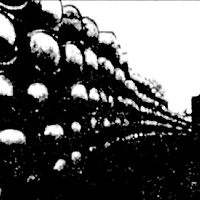 This example is my response to my own inability to
organize a decent amphibious invasion. I hope it will be of use to
others who have struggled to come to terms with the new naval
rules introduced by Second Front. It takes into account the
errata in Europa #37, and I have included references to SF rules
where helpful. Tactical errors and rules interpretation errors
contained here are entirely my own fault!
This example is my response to my own inability to
organize a decent amphibious invasion. I hope it will be of use to
others who have struggled to come to terms with the new naval
rules introduced by Second Front. It takes into account the
errata in Europa #37, and I have included references to SF rules
where helpful. Tactical errors and rules interpretation errors
contained here are entirely my own fault!
[Statements such as this warm the cockles of an editor's heart. FW]
For the purposes of this article, assume you are the Allied player, that an Axis minor port is the target of an amphibious operation, and that friendly Allied ports are within 30 MP.
The target beaches are within CAP range of Allied fighter bases, but not within interception range. Also assume that a preparation turn is available in which to load up the invasion forces. If no preparation turn is available, you must use the first naval step (30 MP) to load the forces, but everyone can still hit the beach within the first 5 naval movement steps. Weather is conveniently assumed to be clear with calm sea conditions.
The resources required for this one assault may not always be available, but I have attempted to provide a detailed example.
D-1 Preparation Turn: Allied Player Turn
Allied Initial Phase
Plan the hexes to be invaded. The RE planning limit is the number of LCs currently in play, plus the number of intrinsically amphibious units (32C).
The hexes to be invaded could include the port hex, but adjacent hexes are preferable. This is because any Coastal Defenses (CDs) defending the port attack at half strength in adjacent hexes. In this example, if the port has a level 1 CD then the naval units can approach and land their cargo without suffering any attack from the CD (33B). The disadvantage is that CAP will be required over both the beach hex and the Port hex. If possible, avoid cities where garrisons can be activated.
Plan airborne operations. (24C)
We will have three waves in the invasion. The sizes and makeup of the various waves are:
Assault (First) Wave
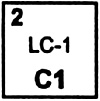 Amphibious assaults are only allowed by intrinsically amphibious units, such as rangers and commandos, and units without HE landing from LC (27B6 and 32). Therefore, use all available LC in this wave; use NTs for intrinsically amphibious units.
Amphibious assaults are only allowed by intrinsically amphibious units, such as rangers and commandos, and units without HE landing from LC (27B6 and 32). Therefore, use all available LC in this wave; use NTs for intrinsically amphibious units.
If the second wave is to travel with the first wave (for convenience of escort purposes), then, from a Major Port (12 RE capacity) consider the following loads:
- Load Package 1: 6 LC carrying 6 RE of non-HE units with 6 NT carrying 6 RE of second wave units.
Load Package 2: 5 LC carrying 5 RE of non-HE units, and 2 NT carrying 2 REs of intrinsically amphibious units, 5 NT carrying 5 RE of second wave units.
With these compositions, the second wave units can conveniently transfer to LCs for landing, and only one escorting TF is needed.
2nd Wave
- Same number of NT as there are LC available, as the cargo will trans-ship to the LC for landing on the beach in the
exploitation phase (31B and 31 D).
3rd Wave
- Prepared for landing on the beach in the next turn, hence the size will be that capable of being handled by the LC. It will also include 3 REs of units to land through the port in the turn following invasion. These should comprise troops who will need to use maximum MPs on the turn they land, for example, engineers, or troops required in the front line.
Allied Movement Phase
Move LCs and NTs to various embarkation ports -- these can be some way from the landing site.
Break down divisions to unsupported components.
Stack in embarkation ports:
- Assault wave: Marine, amphibious, inf regiments and brigades, It AA (non c/m), combat engineers.
- 2nd wave: Division HQs, c/m units (for AECD / ATEC), AA, and artillery for supporting unsupported units.
- 3rd wave: Heavy AA, more troops, engineers, combat motorized units.
Don't forget the cargo loading limits in the embarkation ports -- and that c/m and cavalry units count double their RE size for naval transport purposes.
Load Assault Wave: Amphibious units in NTs, non-HE units in LCs.
Load 2nd and 3rd wave units in NTs.
Move airborne units to airbases with transports.
Allied Exploitation Phase
Move loaded NTs and LCs to transit ports within 30 MP of the invasion site (for the assault wave) or within 120 MP of the invasion site for the second wave. Note: by putting these units in friendly ports, the ground units will be in supply next turn. They do not have to disembark from the NT/LC (27134). Stack TFs with transport groups for escort purposes.
D+0 Invasion Turn: Axis Player Turn
Axis Initial Phase
Put CAP over ports with loaded NTs/LCs or ensure that these ports are within friendly interception range.
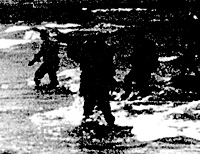 D+0 Invasion Turn: Allied Player
Turn
D+0 Invasion Turn: Allied Player
Turn
Allied Initial Phase
Fly CAP to invasion hexes and embarkation ports.
Allocate units to Naval Patrol if enemy naval interference is possible (20G21i).
Activate conditional reinforcements if desired (CGs).
Allied Movement Phase
Fly coast defense bombing missions (20G2i).
Fly airdrop missions. Don't forget that the first unit to land, airborne or amphibious, activates the enemy garrison (37E).
The Allied Naval Movement Phase of the Invasion Turn
| Step | Assault Wave | 2nd Wave |
|---|---|---|
| Makeup | LC, NT and escorting TF-1 | NT with escorting TF-2 |
| Naval Step 1: | Move to beach Conduct Danger Zone combat when entering Danger Zone (34F) Coast Defense combat is possible. Move the last 10 MP at night, to make enemy attacks more difficult | Move to beach. |
| Naval Step 2: | Amphibious Assault (30 MP) Conduct Danger Zone combat since naval group started the step in a DZ. CD combat is possible. If CD combat occurs, the TF can't start preparing for Naval Gunfire Support (NGS). Otherwise it starts preparing. | Move to Beach. |
| Naval Step 3 | Amphibious Assault (60 MP accrued) Conduct DZ combat since the naval group started the naval step in a DZ. Assume the CD has been silenced. TF prepares for NGS (30 MP) | Move to Beach. |
| Naval Step 4 | Amphibious Assault (90 MP accrued) Conduct DZ combat since the naval group started the naval step in a DZ. Amphibious assault takes place, as 90 MP have now been expended. Resolve Coastal Raids (14H4). If any CDs still survive, coastal raids precede CD combat. Roll for LC damage (34G). TF prepares for NGS (60 MP cumulative expended) | Move to
Beach. DZ combat when entering Danger Zone. Move last 10 MP at night. |
| Naval Step 5 | Trans-ship 2nd wave from NT to LC (30 MP). DZ combat since the naval groups started the naval step in a DZ. TF prepares for NGS, and has now expended the required 90 MP. | - |
After the 5th naval step, the defender may be able to react with his land forces to the landing (32D).
General Note: Do not move the 3rd wave to the target hex during these steps, as waiting until the exploitation phase will avoid it undergoing DZ combat. It should be moved to within 60 MP of the target hex. As naval groups move, check for DZs, Reaction Naval Move, Naval Patrol missions, CDs, and Mines.
(Non-Naval) Movement Phase
Ensure that the next batch of c/m units are placed in nearby ports, within port RE limits for loading.
Up to the LC capacity of c/m units will be required to be loaded in the Exploitation phase (3 1 A). Non-c/m units cannot be loaded in the exploitation phase.
Move non-HE units to airbases for air transport next turn.
For air transport, units must start the mission in the same hex as the transport aircraft.
Allied Combat Phase
Fly DAS, GS. Commit NGS and conduct ground combat.
Units will have their attack strength quartered or halved, depending on their type (32B).
By using NGS, this provides support to all attacking units from the same hex (within normal artillery support parameters), and avoids their attacks strengths being further halved.
Limits apply on the amount of GS that can be used (20G2b). CAP can be converted to Interception missions to drive off enemy DAS, or to Escort missions to protect against enemy interception.
Assuming the attacks are successful...
The beach and port are now friendly-owned, but only the beach may be used this turn for cargo purposes in the phase following its capture (30A and 30B). This will change the DZ status (34F), and should make further naval movement safe from DZ and CD combat.
Allied Exploitation phase
In this phase, any unit may land via LC, including non-c/m units. If the invasion was in adjacent hexes to the port hex, it is worth spending 2 MP to move all naval groups into the port hex. This makes CAP and TF protection easier.
Naval Movement in Allied Exploitation Phase of the Invasion Turn
| Step | LC | NT of 2nd Wave and TF 2 | 3rd Wave | TF-1 |
|---|---|---|---|---|
| Naval Step 1 | All NT, LC and TFs Replenish (34B). This allows NGS preparation again for defense at full strength (34C). (We are assuming basic game replenishment rules). | |||
| Naval Step 2 | 2nd Wave expends toward disembarking. | 30 MP Return to port. | Move to invasion site. | Prep NGS 30 MP. Total of 30 MP now expended. |
| Naval Step 3 | Land 2nd Wave (60 MP expended). Check for LC damage (34G). | Load c/m (30 MP) as a 4th wave | Move to invasion site. | Prep NGS 30 MP. Total of 60 MP now expended. |
| Naval Step 4 | Trans-ship 3rd wave to LC (30MP) | Move to invasion site. | Trans-ship (30 MP) to LC, except 3 RE for Port next turn. | Prep for NGS 30 MP. 90 MP now expended. Prep completed. |
| Naval Step 5 | Start to land 3rd wave. | - | Return to port with TF-2. | - |
Divisions assemble if all components are in the same hex, even if non-c/m (15A).
All naval groups in the same hex combine into one naval group.
Status: At this stage, the 2nd wave is ashore, divisions are possibly assembled, the third is half-way through unloading, NGS is ready for any enemy counterattack, c/m units are available at the invasion site for trans-shipping to LCs and landing next turn, and there is a convoy ready to unload at the port as soon as permitted in the next friendly turn.
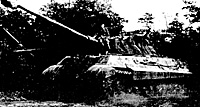 D+0 Invasion Turn: Axis Player Turn
D+0 Invasion Turn: Axis Player Turn
Note: If the Port is destroyed or has maximum damage, it is not considered functioning and cannot act as a supply source (12C2 and 30A4). Supplied troops that made an amphibious landing are automatically in supply for the enemy player turn (32B). This will not apply to second and third wave units, and units still on NTs in the hex.
Isolated troops will defend against counterattacks at half strength. Supplies will need to be brought by sea next turn, or the Port opened by repairing damage.
In this example, a functioning minor port can provide supply for up to 15 RE of units.
Initial Phase
Put CAP over port.
Fly harassment missions to prevent counterattacking forces from reaching the beach.
Combat Phase
Use NGS and DAS on defense.
Remember the limits on the number of NGS uses (34I).
Don't forget harassment missions. Prevent surprises such as this.
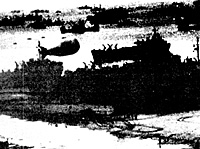 D+1 Turn: Allied Player Turn
D+1 Turn: Allied Player Turn
Status: The port is now friendly-owned, and can be used (if it still has any undamaged capacity).
Initial Phase
Place CAP over Port and also over hexes where engineers may move this turn to construct temporary airbases.
Naval Movement
Land units across beaches and the port.
If the port has hits, then the cargo may need to wait until the exploitation phase in order to land from NTs.
Load the next waves. Ensure you have enough engineers, supplies and resource points, as well as c/m units.
All units replenish.
Movement Phase
Build temporary airbases, and air transport non-HE units across.
Engineers repair port.
Keep sufficient land units in key hexes airbases and the port -- to protect against exploitation movement if there is a successful enemy counterattack next turn.
Combat phase
Expand bridgehead.
Exploitation phase
Land again on beaches and port (if capacity has been enhanced).
Land CAP units on the newly-constructed temporary air bases.
Summary
I hope this rather detailed example helps clarify some of the interactions when carrying out an amphibious invasion. As I said at the outset, it comes from several of my own incompetent attempts, and I am sure will stimulate correspondence from stalwarts who can do better. Amphibious assaults were not taken lightly in real life, and to carry them out competently in SF we too need to practice.
One should also add that there will inevitably be losses in this kind of assault. The plan should therefore not expect that every unit will make it through to the beach.
A future article may concentrate on how the beach can hit back, but this has been enough to start. Enjoy your invasion planning!
Back to Europa Number 46 Table of Contents
Back to Europa List of Issues
Back to MagWeb Master Magazine List
© Copyright 1996 by GR/D
This article appears in MagWeb.com (Magazine Web) on the Internet World Wide Web. Other articles from military history and related magazines are available at http://www.magweb.com